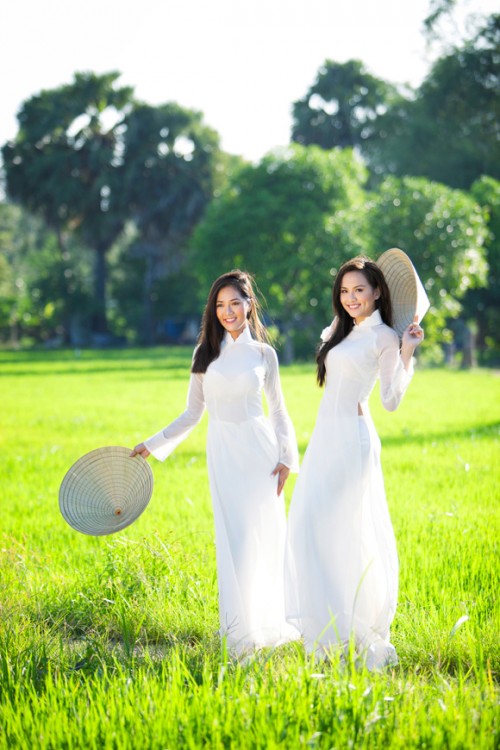
Conical leaf hat
NON LA -THE SYMBOL OF VIETNAMESE ELEGANCE

For a long time, the image of young ladies with a
conical palm leaf hat known in Vietnamse as “Non La” has become a
symbol of Vietnamese charm and beauty. Along with Ao Dai, the
Vietnamese traditional long dress, the hat stands for national
costume identity now broadly recognizable around the world.
Though appearing very fragile, Non La is in fact fairly strong as it
is designed to withstand intense use and the impact of adverse
weather conditions. In the tropical condition of Vietnam with plenty
of sun and rain, Non La was a useful headgear to protect ancient
Vietnamese from sun and rain. Besides, women can use Non La as a
basket for when shopping in the market or a hand fan in hot summer
days. Beside the practical purposes, it especially enhances the
feminine grace when combined with Ao Dai – the Vietnamese long
traditional dress.

Vietnamese ladies in Ao Dai and Non La
Up till now, the exact origin of Non La is still a question.
However, the hat’s image was embossed on two Vietnam’s ancient
artifacts such as bronze drums dating back 2500 - 3000 years ago. It
indicates that Non La was already popular during this period, or
perhaps even earlier. As a part of Vietnamese lifestyle, Non La has
maintained its presence through all stages of war and peace of the
country’s history. It is prominent in folklore as well as nowadays
festivals.
Non La is creatively hand-made from simple materials of nature
including palm leaves for roofing and bamboo for frame. The hat’s
outer surface is often covered by a layer of clear varnish to
increase smoothness and water resistance. The making process
requires experience, patience and skilled hands. Apparently, no
machine is able to replace the traditional techniques inherited
throughout generations of craftsmen to whom Non La making has been
their livelihood.
In addition to the original version, Non La has many variations such
as Non Ngua (horse hat) from the coastal province of Binh Dinh in
Central Vietnam or Non Quai Thao (flat palm hat) from a number of
Northern provinces. Specific regions have their own ways of making
their version of hat unique. However, it is commonly agreed among
Vietnamese that the most beautiful variation of all is Non Bai Tho
(poem hat), which is originated from Hue, the ancient capital of
Vietnam, land of picturesque landscapes and famous poets. The
decorative images such as the lotus blossom or the Buddha face are
delicately imbedded between two layers of palm leaves and only
visible in direct sunlight.
There are many villages along Vietnam making Non la for a means of
living. Chuong village in a suburban district of Hanoi named Thanh
Oait the city’s center, is one well known location for its
traditional hat making trade lasting through three centuries. Chuong
villagers are very strict in selecting materials only sourcing the
best from palm growing Northern provinces. The village produces
thousands of hats per day for purposes of personal use, tourism
souvenirs and export. The village is now a highlight of Vietnam day
tours in the North for foreign tourists. A short drive from Hanoi
will take tourists to Chuong village where they can enjoy
discovering how Non La is made, listening to the stories of Non La’s
history and learning more about Vietnam’s culture. After all, one
thing they cannot afford to miss is taking back with them a
hand-made Non La as a unique souvenir from Vietnam.
English
My brother
Eyewitness and victim of Vietnamese communist
crimes during the
1968 Tet Offensive
Life story of a former Vietnamese boat people refugee
Letter to my
children and grandchildren
What now, Mama?
Wicked maneuvers of political games by Ho Chi Minh and the CPV
The Battle of Kontum
The Soul of Vietnam - Audio
Ever since you came
Night of the Flowered
Lanterns
The Passionate
Heart of a Father
I have already gone..
Soldier Excellence Award
Tomorrow I will go...
Trip to Vietnam Revives Hatred of Communism
Colonel NGUYỄN MẠNH TƯỜNG
The true about the Vietnam war
Letter to Descendants
Conical leaf hat
Touched by an Angel
Portland photographer behind viral Ferguson rally 'hug photo' knew
'this kid was special'
Cherries – A Vietnam War novel
The Blood-Red Hands of Ho Chi Minh
Carl Vinson Officer Receives Writing Award
Remembering the fallen
History of South Vietnam Marine Corps
Captain James Van Thach